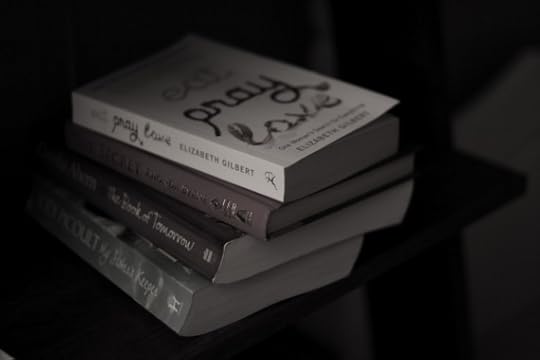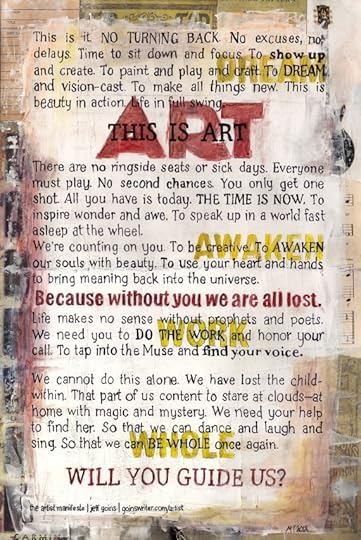Jeff Goins's Blog, page 87
November 24, 2012
The Online Writer’s Guide to Cyber Monday
I loathe Black Friday. I don’t even leave the house. There’s nothing I hate more than being stuck in crowds, wasting hours in line. Even if I do get a good deal, it’s not worth the stress.

Photo credit: Bruce Turner (Creative Commons)
I’m glad they invented a post-holiday holiday for lazy people (like me): Cyber Monday. I can do most of my holiday shopping from the comfort of my couch and still save a ton of money.
So if you’re like me and love a good deal that doesn’t involve waiting hours in line, then you’ll love this guide to Cyber Monday shopping for writers. So warm up some turkey, kick back, and start clicking…
Get equipped with the right resources
Get educated. Corbett Barr has a great course (that I’ve taken) called How to Start Blog that Matters. Normally, it’s $97, but just for today, it’s only $57, which is CRAZY cheap. If you’re still trying to figure out this blogging deal, check it out.
Get awesome. Chris Guillebeau is offering a 15% discount on all of his individual “unconventional guides” (using the code STUFFING) and 25% off combo packs (using the code PIE). I love everything Chris puts out — from travel tips, to how to become a writer-entrepreneur, to shirking the expectations of what society deems “normal.” See what he’s got.
Grab a premium blogging theme. StudioPress is doing another massive sale, discounting their products at 25% off. This includes Genesis, the framework on which my blog is built. If you want a blog that looks just look mine, you first need to buy Genesis and then pick up the Tribe Child Theme, which is also on sale for 25% off (code: cybermonday).
Get published. Through today only, Michael Hyatt is offering a $200 discount on his GET PUBLISHED audio course. This is a great program that I’ve gone through, recommend, and have even contributed to. Check out the promotion.
Improve yourself
Get inspired. Amazon has 100 Kindle eBooks on sale for under $3.99, including The Writing Life by Annie Dillard (for only $1.99!).
Become a photographer. Alli Worthington has a great, little eBook about how to master the art of photography, using an iPhone. This book is practical, visually engaging, and fun. Check it out.
Take your blog to the next level. One of the most useful books on the subject of blogging is 31 Days to Building a Better Blog by Darren Rowse. Not to mention, Bryan Allain’s 31 Days to Finding Your Blogging Mojo is the FUNNIEST book on the subject I’ve ever read. Also, Community Wins is another gem.
Get strategic about releasing your next eBook. Sarah Mae’s How to Market and Sell Your eBook is an essential read for anyone who wants to go into ePublishing. At only $4.99, it’s a steal.
Fall back in love with writing. If you haven’t picked it up yet, my eBook You Are a Writer has inspired tens of thousands of writers to make take that bold step into declaring themselves writers and then going to work. It’s currently 25% off (along with everything else in my online store).
Join a community. I’ve been a member of the Killer Tribes Community for two years now, and it’s been a great source of encouragement and inspiration. Looking to connect with other bloggers? Do it here.
Make sure you have the right tools
Get an eReader. Been holding out for a Kindle? You can now get one for as low as $69. Don’t miss it.
Get the right writing software. I do most of my writing in a simple text editing app, but when I need to get rid of distractions and focus, I use Ommwriter. They just came out with a new version, and currently it’s pay-what-you-want, which is cool. Check it out.
Get your blog hosted. The #1 problem with most bloggers is they don’t understand the value in owning their platform. Let me be clear: if you don’t have a self-hosted blog, you don’t own your content. You’re renting some space on the web; that’s it. With Bluehost offering hosting packages for as low as $3.95, who NOT get a host? Try it here.
Start an email newsletter. If you’re trying to build a presence online, having a newsletter list is essential to communicating with your audience. Try Mailchimp for free.
Two exclusive offers from me
1. I’m offering a 25% discount on any item in my store. If you haven’t picked up one of my products, now would be the time to do it. Offer is good only through end of the day today.
The no-brainer option is The Writer’s Studio, which is only $15. The best deal, though, is The Pro Writer Package, which includes all my stuff ($107 worth of product) for $37.50. Both include an exclusive bonus you can’t get anywhere else. See everything in my online store.
2. If you order a hard copy of my book Wrecked today and forward me your receipt, I’ll send you a free audio teaching (a $20 value). This is 35-minute talk on writing I did called “How to Fall Back in Love with Writing” and was one of the best talks I’ve ever done. Use the subject “Wrecked Cyber Monday” so we can filter it accordingly (and give us 24 hours to send you the file to download).
What did I miss? Share in the comments any Cyber Monday deals for writers that I may have overlooked.
*Photo credit: Bruce Turner (Creative Commons)
Disclosure: Some of the above links are affiliate links, but I only endorse products I believe in.

November 22, 2012
You Don’t Have Thanks, You Give It
At a time when many people have seen better times, it’s easy to look at a day called “Thanksgiving” and scoff. To wonder: What do I have to be thankful for?

Photo credit: martinak15 (Creative Commons)
For years, I misunderstood gratitude. I thought it was about feeling grateful for the gifts around me. But when I didn’t feel I had anything to be grateful for, I wondered what was wrong with me.
Now, I get it: You can’t have thanks; you can only give it. (Feel free to tweet that.)
Gratitude is a discipline
The more you practice feeling grateful, the more grateful you become.
Gratitude is a muscle you strengthen through daily use — an exercise, not an emotion. It’s not something you feel, but something you do.
And like most things, the people who are best at it are the ones who do it even when they’re tired and worn out and don’t much feel like it.
So what does this mean for you? I don’t know…
Listen: I can’t tell you what you have to be thankful for; only you know that. (And frankly, if I did, I wouldn’t want to; that’d be pretty presumptuous.)
However, I am confident that you have the same opportunity we all have today: to give thanks or not. To choose to see a few gifts hidden in that life of yours. To use your gratitude muscle or let it lie dormant.
If you do, you may surprise yourself. You may find, as others have, that the more you utter the words, “thank you,” the more gratitude that pours out. It’s a funny thing. But sometimes the right attitude doesn’t come until you show up to do the work.
Go be grateful
If you’re up for a little challenge, do something counter-cultural today.
When most people are looking for someone to blame for their current state of affairs, be different. Don’t sit around waiting for gratitude to come. Instead, give thanks.
Without prompting or pushing, find something to be thankful for. Speak it, and believe it. Then watch that gratitude muscle grow.
If you need a little prompting, check out this book (affiliate link), or read my “10 Reasons to Be Thankful” post.
What do you have to be grateful for? Share in the comments.

November 20, 2012
How to Become World-class at Anything: An Interview with Tim Ferriss
We all want to feel more like directors in our own lives and less like spectators? We want to be the boss, not the victim. Don’t we? What if I told you a cookbook could help you do that? Crazy, right? Maybe not…
I recently had the opportunity to interview best-selling author Tim Ferris, and we chatted about that very idea.

Chef Tim
In this exclusive interview, Tim and I talk about his new book, The 4-Hour Chef, which launches today and is about a lot more than cooking.
Listen to the interview
Download: Tim%20Ferriss%20Interview.mp3
Click here to download the MP3.
More about The 4-Hour Chef
This book isn’t just another cookbook. It’s a guide to taking back control of your life, a blueprint for becoming the jefe of your own story.
Spread throughout The 4-Hour Chef is the idea of meta learning (essentially, learning about learning) and the process by which someone becomes world-class at anything (including cooking).
Tim is renowned for cracking the code on seemingly complex processes and breaking them down. He did it with his previous two books (both were NY Times Best Sellers) by tackling the issues of time management and weight loss. And now, he’s teaching us how to cook.
But this is just another rodeo for Mr. Ferriss. Long before his success as an author, he was mastering Japanese by reading comic books, becoming a kickboxing champ in China, and going toe to toe with tango world champs in Argentina.
Interview highlights
Here’s what Tim and I discussed in this exclusive interview:
How Tim approaches learning, cooking, writing, and other stuff
Why being born premature (and having other weaknesses) has helped him become who he is
What his greatest weaknesses are, how he’s not superhuman, and why failure is no excuse to quit
Why he doesn’t write for just one genre and what he’s learning from releasing a book only on Amazon
And a lot more!
The secret to becoming world class
Like I said before, this book is about a lot more than cooking. It’s about how we learn to do things we’ve never been good at.
In The 4-Hour Chef, Tim breaks down his approach to rapid skill acquisition — and how you can replicate the same process for anything you want to learn.
So… what’s the secret to becoming world class at anything? Here’s the answer in Tim’s own words:
“The way that you become world-class is… by asking good questions.” —Tim Ferriss (Click here to tweet that.)
How to get access to an exclusive Q&A with Tim
Here’s a cool opportunity Tim is offering you guys just for listening along to this interview. If you buy three hard copies of his new book, you’ll get access to an exclusive Q&A with him after the book launch. Here’s how it works:
Buy three print copies of The 4-Hour Chef (affiliate link).
Email the receipt to 3books(AT)4hourchef.com.
You’ll then receive an invitation to an exclusive, two-hour, live Q&A with Tim Ferriss, where you can ask him anything.
What’s something that you’d like to be world class at? Share in the comments.

November 15, 2012
The Reason Your Marketing Is Utterly Failing
There’s a reason people aren’t paying attention to your message, why they won’t give your blog or business the time of day. There’s a simple cause for why others aren’t listening to what you’re saying.
You’re missing a crucial ingredient to all effective marketing, to getting your ideas to spread. In fact, it’s the ingredient. What is it?
One simple word: Permission.

Photo credit: Greg Habermann (Creative Commons)
It’s how blogger Seth Godin builds a powerful tribe of followers for every project he launches — with nothing but a blog and a great idea.
It’s how the nonprofit charity:water gets thousands of people to promote their cause every year, voluntarily raising millions of dollars for clean water wells in the developing world.
No coercing. No advertising. Just permission.
What is this permission you speak of?
Permission is the formal consent to do something (duh). If you have it, you never have to apologize for interrupting someone or promoting something that’s important to you. You’re already “in”; you’re allowed.
It’s the equivalent of waiting your turn at dinner to say something. You know you’ll get your chance, because you’ve been invited to the table.
Permission is polite. It’s courteous. It’s what every customer dreams of, what every reader of your writing is expecting. It is the #1 most-neglected discipline in most mass communication.
And it could be the reason why your marketing is awash.
How does this apply to you and your message?
There are two ways to get your voice heard:
Interrupt people (90% of the advertising messages you encounter today will be guilty of this).
Earn permission.
The first is typical. It’s anticipated. You see it all around you every day. It’s the reason we walk into a store and tell the saleswoman, “No thanks, I’m just looking” when she asks if we need help.
Of course, we’re usually lying. We are looking for something. We just don’t want to be sold something; we want to discover it for ourselves. Permission-based marketing lets you do just that.
The second (earning permission) is rare and unexpected. It’s the reason we love Amazon and use iTunes. These virtual environments of choice allow us to browse on our own agendas.
Because we’ve given them permission, they quietly suggest titles to us as we shop. And we don’t mind one bit.
How to get permission to do anything
Permission is about trust. Everybody wants it, but few are willing to work for it. Here are two ways to get permission:
Ask for it.
Earn it.
Doing the first is obvious and often necessary, but what you want is the second route. This is where lifelong fans are made.
You want to create something so compelling, so cool, that people are willing to beat your door down to see and share it with others.
Permission is valuable; that’s why it takes hard work. If you don’t have it, you’ll never grow. Your brand, business, blog, whatever will stagnate and die. You’ll always struggle and feel flustered — and it doesn’t have to be that way.
How to tell if you don’t have permission
If you open up every blog post with an apology…
If you know you’re interrupting and do it anyway…
If your marketing plan is a math equation instead of a simple strategy to help people…
If you say, “It’s a numbers game,” at least once a day…
…Then you probably don’t have permission. And that’s exactly what you need if you don’t want to get lumped with all the other self-promoting sleaze bags.
So it’s time to start: to do the work and build one loyal fan after another. It will take time and effort. It will be exhausting and frustrating.
You’ll take two steps forward and three back. You’ll want to quit or get fired. You’ll beg for an easier way. But there isn’t one.
This is why permission is so valuable. Sure, there are more expedient ways to spread a message, but none more effective or sustainable. It makes sense that the marketing you don’t have to apologize for — the kind your followers will thank you for — is the hardest to come by.
It’s because it’s worth it.
Want to get started?
If you’re ready to do marketing differently, you should start by reading the book Permission Marketing by Seth Godin. Everything I learned about this topic I owe to him. (If you don’t want to pay for it, you can get the first third of the book for free here.)
Whatever you do, don’t file this in the “nice to know” category and go back to your spammy email blasts and fearful ad campaigns. Do something unique. Do something remarkable. And do it with permission.
Your fans, friends, and customers will thank you. (Oh, and just for fun, here’s a list of hilarious marketing fails.)
What’s an example of permission marketing that you like or use? Share in the comments.
Disclosure: The above book link is an affiliate link, which means I literally make pennies off your purchase.

November 13, 2012
How to Tell Your Story without Boring Your Audience to Tears
Have you ever listened to someone tell a story — over coffee, at church, or at a conference — and been absolutely bored to tears? Or worse: the story was interesting, but there doesn’t seem to be a point?
Join the club.

Photo credit: Julien Harneis (Creative Commons)
Maybe the meat of the story you heard was interesting, but for some reason you just couldn’t stay engaged. Or perhaps you heard an anecdote that completely blew you away, but when you tried to retell it, it didn’t have nearly the same impact. Why was that?
Chances are — whether you realized it or not — the person was using dynamic storytelling elements.
We are all have stories to tell. And even if a person isn’t a professional author or speaker, we still need to learn to tell our stories well.
Because in hearing other people’s stories (and telling our own), we often find understanding and acceptance. Stories help us feel not quite so alone in this world.
So if you need some help, here are three simple steps to how to tell a more compelling story:
1. Use a hook
A “hook” is your opener. It’s the attention-getter, the question or quote that immediately hooks your listener or reader. The more off-the-wall or mysterious, the better.
Dare your audience to get lost in the story.
2. Tell the story
A story has natural momentum to it. If you simply state what happened in chronological order (many people actually neglect doing this), you will captivate your audience.
Ira Glass calls this the “anecdote” — a story in its purest form —† and likens it to a train on which you’ve invited others to join. Those riding along can feel that you’re headed towards a destination.
Glass also says you need “bait” to keep your audience engaged. As he defines it, bait is a series of implicit or explicit questions you, the storyteller, raise.
Just remember: any question you raise, you’ll need to answer. Otherwise, you’ll leave the listener in perpetual suspense.
3. Reflect
Many people seem to tell stories just to tell them. But when you start asking why people share (and listen to) stories, often there is an objective. A reason. It may be to encourage or inspire or cause you to think differently. But still there is purpose to the telling.
At the end of your story, take a moment to reflect on what you shared. Answer any questions you’ve raised:
Why is this relevant?
What’s the moral or point?
Who is this message for?
Help us, the audience, understand what we’re supposed to get from the story. It doesn’t have to be cliche or cheesy; in fact, your reflection can even be subtle. Just make it count.
In the reflection, you must resolve any questions or conflicts that were raised. This is, essentially, your conclusion. Your resolution.
This can be a great opportunity to revisit your hook. Wrap up with a mention of your attention-getter or a restatement of a quote, interesting fact, etc.
This is your chance to make sense of anything that seemed superfluous at the time. Bring it all home.
Your story is waiting…
I’ve helped lots of people tell their stories. And more often than not when a story is suffering, it’s due to neglecting one of these practices.
The teller jumps straight to the reflection or doesn’t take the time to grab the audience with a hook. Or he drones on and on anecdotally without explaining why he’s telling you the story in the first place.
The result is confusion and even frustration.
Your stories deserve better. So does your audience.
How do you make your storytelling more compelling and dynamic? Share in the comments.
Want to tell better stories? Check out the books Save the Cat and STORY. They will help you hone this craft of storytelling.
* Disclosure: The above book links are affiliate links, which means Amazon pays me a commission on anything you buy through that link (at no extra cost to you). It’s just a nice way to pay for diapers.

November 9, 2012
When Fear Is Your Friend (and When It’s Not)
Do you feel a twinge of nervousness every time you publish a blog post? Need an extra gym session when you submit a manuscript revision? Have to give yourself a pep talk before reading aloud at your writer’s group?
Here’s a secret: We all do. We all are afraid.

Photo credit: Steven Depolo (Creative Commons)
Feeling nervous before you ship is normal. In fact, if you don’t feel a little fear when you release your work into the world, you’re probably not putting your whole heart into it.
So how do you get past that scary feeling in your gut and get your work out into the world?
The key is being able to tell Good Fear from Bad Fear.
After that, all you need to know is how to make that fear work for you (believe it or not, it’s possible).
The difference between Good Fear and Bad Fear
What’s the difference between these two types of fear?
Good Fear is the kind that screams, “RUN!” when a bear shows up at your campsite.
It’s that knowing feeling in your gut when you’re about to make a bad decision. It’s the lump in your throat that tells you to hold back when you’re not ready to put your best foot forward.
In other words, Good Fear is the kind you should listen to. And Bad Fear is its evil stepsister.
Bad Fear is what stands in your way when you try to leap outside your comfort zone. It says you’re safer when you stay put. It’s the enemy you need to stare down — if you’re going to achieve your dreams.
Unfortunately, sometimes it’s hard to tell the two fears apart. It’s easy to mistake the good kind from the bad kind, and sometimes Good Fear even turns into Bad Fear that holds you back.
How I faced the fear of quitting
In the weeks leading up to my decision to quit my job and make a living as a writer, I had a horrible feeling in my stomach. I was scared. Scared to make the right choice. Scared to tell my boss. Scared to leave behind a reliable paycheck.
Much of this anxiety stemmed from the decision to leave a “good job.” I didn’t hate my job; it was good and secure.
So why in the world would I think about leaving? Was I crazy? I mean, who does that — in this economy?
Even though I was head-over-heels excited about the potential of working for myself, I was still petrified of taking the leap. That feeling was Bad Fear, and I knew it.
I knew if I allowed that fear to guide me, it would keep me from accomplishing something great. To kick it to the curb, I reminded myself: When you’re preparing to take a big risk, anxiety is normal.
The fear might never go away
Every time I release a new guide as part of my business, I face this same fear. I wonder: Will people like it? Will they learn something? Will they be satisfied? Will they tell their friends?
I think the same thing we all think when taking a risk: What if I fail? When this happens, I bring out the Good Fear/Bad Fear meter. I ask myself:
Is this the kind of fear that will push me to create my best work, or will it instead prevent me from releasing my ideas to the world?
If the former, I hold back. I wait until I get to excellence. If the latter, I push through and persevere.
You have a decision to make
You have a message the world needs to hear. Believe it or not, whether they hear it is up to you — and you alone. You can let fear control you, or you can use it:
Let fear propel you toward your goals. But don’t let it scare you away from bigger dreams.
Let fear push you to do your best. But don’t let it keep you from shipping.
Let fear help you stay grounded. But don’t let it keep you from living the life you’re meant to live.
Know the difference between Good Fear and Bad Fear — when it deserves your attention, and when you should tell it to take a hike and just keep chugging along.
When’s the last time you were afraid to move forward, and how did you? Share in the comments.
Note: Alexis has a special offer for readers of this blog for the next week. You can buy two of her eBooks for the price of one. If you’re interested in starting a side business and/or launching a successful social media strategy, check out these guides.

November 5, 2012
The Artist Manifesto: Will You Create?
What does it take to be an artist, to be a creative force for good in the world? Months ago, I penned some words trying to answer that very question.
I commissioned my friend, the talented Mandy Thompson (who knows better than most what it means to be an artist), to put some visuals to the words. Here’s what we (she) came up with:
And here’s my boring text version:
The Artist Manifesto
This is it. NO TURNING BACK. No excuses, no delays. Time to sit down and focus. To show up and create. To paint and play and craft. To DREAM and vision-cast.
To make all things new.
This is beauty in action. Life in full swing. THIS IS ART.
There are no ringside seats or sick days. Everyone must play. No second chances. You only get one shot. All you have is today.
THE TIME IS NOW. To inspire wonder and awe. To speak up in a world fast asleep at the wheel.
We’re counting on you. To be creative. To AWAKEN our souls with beauty. To use your heart and hands to bring meaning back into the universe.
Because without you we are all lost.
Life makes no sense without prophets and poets.
We need you to DO THE WORK and honor your call. To tap into the Muse and find your voice.
We cannot do this alone. We have lost the child-within. That part of us content to stare at clouds — at home with magic and mystery. We need your help to find her. So that we can dance and laugh and sing. So that we can BE WHOLE once again.
WILL YOU GUIDE US?
Share this manifesto
If this resonates with you, feel free to share this page with a friend. You can pin it, tweet it, or Facebook it.
You can also print it off or save it to your desktop. Heck, you can even repost it to your blog or website, if you want (just link back here, please).
Here are a few tweetable quotes:
“This is beauty in action. Life in full swing. This is art.” (Tweet this)
“We’re counting on you. To be creative. To awaken our souls with beauty.” (Tweet this)
“Life makes no sense without prophets and poets.” (Tweet this)
This is something we’re sharing, because we want to see it spread. And if you want something more than a version for your computer screen, read on…
How to buy a print
Okay, before your defense mechanisms go up, you need to know two things:
Mandy did all this work for free. She’s a talented artist who deserves to be compensated for her work somehow. She’s also recently opened up her home to foster two little ones, so you can imagine how a little extra cashflow wouldn’t hurt.
I won’t be making a dime off of any of this. No affiliate deals here. I just wrote the thing; she turned it into a piece of art (and therefore deserves the credit). My hope is she’ll find a few kind patrons in you lovely readers.
If you’re interested in picking up a collector’s edition print (supplies are limited), Mandy has several versions of the manifesto in her Etsy store (click the links below to find out more about each):
6×9 digital print: Great for framing and placing on your desk or small wall space as an important reminder to create. Only 14 available.
11×17 digital print: Perfect for hanging on your wall to call you to action when you need it. Only 18 available.
12×18 professional print: This is professionally reproduced giclee print, a collector’s item if I ever saw one. The amount of work that went into printing this is a story in itself. Only 12 available.
12×18 signed print: Same as above, but signed (at my request) by the artist. Only five available.
12×18 original: This is THE original piece Mandy created on heavy cardstock, using acrylic and gesso as the backing for the hand lettering. It is one of a kind. Only 1 available.
This week only: If you use the code “MANIFEST,” you’ll receive 25% off your total order. This is a great gift for the art lover in your life and goes to a totally worthy cause: the artist. See all the prints here.
If you wrote a manifesto, what would it be about? Share in the comments.

November 3, 2012
The Best Way to Get a Story to Spread: Give It Away
Did you know George Washington probably never chopped down a cherry tree? And Benjamin Franklin never flew a kite with a key in a thunderstorm.
So why do we remember these tales? What about such stories makes them spreadable? If it’s not their veracity, what is it?

Photo credit: D Sharon Pruit (Creative Commons)
According to the Heath Brothers, the reason some stories stick and others don’t is because they contain certain key elements: simplicity, unexpectedness, concreteness, credibility, emotional appeal, and a compelling narrative. If a story has these, it is far more likely to spread — even if it’s not true.
So what do you do if you have a story that is true or a message people need to hear… but nobody cares?
Why not give it away?
If you’re a subscriber to this blog, you know I’m a fan of “free.” Granted, it’s not the best method for making money (duh), but it can be an excellent marketing strategy, if done right.
“Free” is easy. It’s a low barrier to entry and often a surprise, which is why it works in spreading an idea. The Bible is free (thanks to the Gideons). So is the encyclopedia now. You can even find classic works of literature on Amazon for nothing.
Why do these books continue to sell, despite the fact that they’re free in some places? Because the stories have spread, and people see the value in them.
People will buy goods they can get for free (and do). The trick is making the right people aware of them. The hard part isn’t making the thing; it’s earning attention.
The cost of “free”
Charging money for your content or art makes it harder for strangers to find and then spread. If want to get your work noticed, one way to do it is to be generous.
In a world full of distractions, what is attention worth to you? The cost of a book? A few hours of your time? A free MP3 download?
Would you be willing to give up something valuable in order to get access to more people? Of course you would. This is what advertising is all about. But these days, giving away your product is way more cost-effective than an ad.
So why don’t more people do this?
The problem is fear. We’re afraid people won’t care or no one will pay us for our work ever again. But the reality is this: “free” is a great way to get noticed. And of course, that’s just the beginning.
But it’s a start.
How this works
So let’s say you’re ready to do this, to give your work away for free to earn some attention. What now?
Create something valuable you could charge money for.
Give it away for free (possibly for a limited time to create urgency).
“Charge” people a piece of personal information in order to get the goods (e.g. an email address). This will make them value it more and help you measure success.
Use that info to build trust with your new fans and slowly turn them into customers.
Keep creating awesome stuff to both sell and give away.
The job of an artist is to earn attention, build trust, and deliver value. If you do that, you most won’t go hungry.
Examples of “free” that work
Songwriter Derek Webb did this with his record, Mockingbird, in 2006. In a few months, he collected over 80,000 email addresses and used that list to plan his next concert tour. He now helps other musicians do this with Noisetrade.com
I did something similar when I gave away an eBook to get people interested in an online course I was building.
Paulo Coehlo did this when he gave away The Alchemist and it eventually became an international best-seller.
My friend, Max Dubinsky, is doing this right now with his new novella (with the help of a network I helped create).
Everywhere you look, people are finding interesting ways to get their work noticed — even if it means giving it away.
What this means for you
Most artists struggle with getting their work noticed. They have a marketing problem. This is especially true for writers — they just can’t seem to get people to read their work. If that’s you, here’s a reality check:
Until you stop being stingy with your art, you can’t feel frustrated at your lack of audience. [Click to tweet]
So if you’re upset that more people don’t care about your work, ask yourself, “What do I have to lose in being generous?” Why not give away a piece of work in exchange for some eyeballs?
Free isn’t a guarantee of success, and you can certainly cannibalize your market. But if what you really care about is spreading a story — and you’re determined to figure out how to make money after people start caring — it’s a legitimate strategy for earning attention.
What you do after that is up to you.
Have you ever benefited from “free”? Did it make you a fan of something newt? Share in the comments.
Want a free book? Go grab Max Dubinsky’s new novella on Amazon and see how he’s using “free” to build a tribe of readers.

November 2, 2012
Yes, We DO Judge a Book By Its Cover
As the owner of a website that promotes eBook deals, I receive a lot of self-published submissions. When I sort through these books, more than three quarters are rejected in the first three seconds. Why? The book cover is poorly designed.
If you’re a self-published author (or even a traditionally-published one), I have some bad news for you: Your book is being judged by its cover.

Photo credit: Zitona (Creative Commons)
Information overload
With the rise of the digital revolution, we are bombarded with information. There are tweets and status updates, countless articles and blog posts — all awaiting your consumption. We have plenty to read.
Adding to the noise, there are more and more self-publishing efforts, which is now easier than ever. Check a few boxes, click “upload,” and in 12 hours you have an eBook in the Kindle store.
Because of the ease of self-publishing, there is a plethora of new authors, each looking to squeeze their way into your reading list. So what do you do?
The Wild West of publishing
A lot of the ease and speed of self-publishing comes from a lack of critical interaction. No one will read it, critique it, and send it back for editing. No one will examine your book for literary excellence and accuracy. There’s no one to judge your book cover — and that poses a problem.
What you submit is what they will publish, no questions asked.
As you can imagine, this makes the self-publishing section difficult to filter through. There are some great books being written, but they’re often hidden in the mess.
Bad teachers and bad writers hold this section hostage, bringing down the value of the whole publishing neighborhood. This is why I recommend authors publish through an agency that will not just publish anything.
Being aligned with a respected self-publishing agency (sometimes called “hybrid publishers”) moves your book from the “hood” to the “burbs” in the self-publishing world.
Snap judgments are inevitable
Even if I had the desire to read every book submitted to me, I couldn’t. There’s just not enough time.
I have to make decisions about each self-published book without actually reading it. Many of your prospective readers are making the same judgments.
So what do you, the author, do to ensure people pay attention to your work? When examining a book, I look at the following:
the book summary
the education and experience of the author
the self-publishing agency used
who endorsed the book
who wrote the foreword
what other titles the author has written
However, with more than three-quarters of the submissions I receive, I don’t look for any of these. I don’t have to.
If the book cover is bad, my research is done. The eBook will not be promoted on our website.
First impressions really matter
Why such emphasis on a book cover?
We know how important a first introduction is. It’s why we dress up before a first date, give a firm handshake at a job interview, and make a meal look good before we serve it. First impressions matter.
We all make instant judgments that either give us hope or lower expectations. With your book, the cover is the all-important first introduction. It’s a visual representation of your writing. And a bad one gives people the impression that you don’t care about quality.
Makes for a great indicator
Your book cover also functions as an indicator or quality. It shows us how much care has gone into the whole project.
An exceptional cover gives us hope that the book may be exceptional. And a poorly designed or low quality cover conveys a lack of care.
If you rushed your cover, maybe you rushed your writing, too. If you wouldn’t hire a graphic designer, you probably wouldn’t hire an editor, either.
Right or wrong, that’s the line of logic being used to judge your book. And you need to be aware of this.
Book cover recommendations
Before you proceed with publishing, take some time to make your first impression count.
Consider getting your book cover professionally designed. You can use a service like 99 Designs or Crowdspring, which both give you options from different designers.
Remember: the cover you choose is a reflection of your whole book, so choose wisely. You’ve spent a lot of time writing it; don’t give someone the opportunity to dismiss it in the first three seconds. You deserve better, and so do your readers.
Be honest: Do you judge books by their covers? Share in the comments.

October 31, 2012
Five Ways to Build a Thriving Community
My friend Bryan just released a new book on community-building. The guy’s a master at it. He’s been blogging for over a decade and has helped hundreds of people and a few organizations build dedicated audiences around their art.

Photo credit: Jayel Aheram (Creative Commons)
So I got to thinking: What lessons have I learned about community-building with this here blog? Here are a few:
Building a community isn’t hard, but it takes time.
Building a community is what leaders do, so courage is a must.
Building a community is all about trust.
Every time I’ve failed at or been frustrated with extending my reach, it’s usually because I’ve compromised one of those values.
Community-building tips
So what does it take to really build a community? Here are five ways to begin:
Identify a common struggle. Everyone has pain or discomfort that they want to go away. Solving a problem (or even just sharing the lessons you’ve learned) is a great way to connect with people.
Be the underdog. We all love rooting for an unlikely hero. When someone who doesn’t have a chance succeeds, anyway, we feel like we’ve succeeded (because we can all relate to being the underdog, sometimes).
Criticize something that’s broken. We all see things in society and culture that don’t work. However, few people have the courage to stand up and say something. If you call out the things that are obviously dysfunctional, you will immediately have an audience, nodding along.
Tell a compelling story. We all love great stories, especially if we can somehow see ourselves as one of the characters. Narrative is what shapes our drives the direction of our lives, so telling a story will immediately capture attention and empathy.
Be generous. This is the very best way to earn people’s attention and trust. Give away your time, resources, and ideas, and you will have fans for life. You don’t have to do this all the time, but doing it once in awhile doesn’t hurt.
Ultimately, this comes down to adding value and helping people. There’s a lot noise in our world, so the best voices get heard by building a platform that isn’t all about them.
In other words: When you make your community about other people, they will make it about you. (Tweet that)
Of course, that’s not the goal of a community, nor should it be the primary motivation for starting one. But it’s a pretty nice byproduct.
Giving and getting from this community
In the spirit of this post, it only seems fair to give you a few opportunities to give and get. Here are a two freebies and a couple opportunities to show your support:
Download a free copy of my “How to Start Publishing for Kindle” program (a $47 value). This offer is good only through Nov. 1, 2012. After that, it’ll probably go on sale.
Grab a free copy of Community Wins by Bryan Allain (offer good only through Nov. 3, 2012).
Buy a copy of The Writer’s Studio , for yourself or a friend. This is an audio program (which includes a copy of my eBook and six writing exercises) that I put together to help anyone get started writing. If you don’t have $20, you can always pick up one of the other eBook packages I have.
Sign up for Michael Hyatt’s GET PUBLISHED course. I’m an affiliate for this course, which means if you sign up for this excellent program, I get a nice commission. Act now, though, because today is the last day to get it at a discount.
So there you go. If you appreciate all the advice and content I share here, buying something once in awhile is a great way to show your support (but definitely not required). Regardless, I’m indebted to you.
I want you to know how much I appreciate your attention. It means the world to me. I can’t believe I get to write words every day that thousands of people read. It’s truly an honor. Thank you.
If you’re not already a member of my tribe, why not sign up for free email updates? I occasionally send special offers and deals (including free stuff) you can’t find anywhere else (not even on the blog).
What community-building tips would add to my list? Share in the comments.





